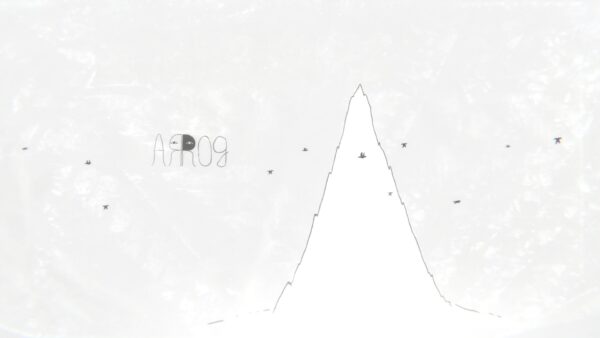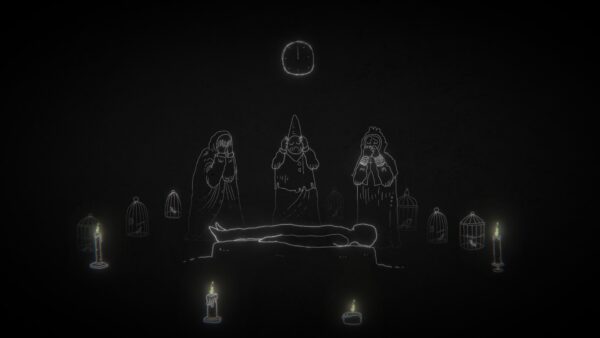Long time readers will know I have a penchant for games with great visuals, superb sound work and a high concept. These are my review-bait titles: ones that the second I see them I know I have to play them because I simply enjoy soaking myself in their audio-visual glory. They’re the one type of game where I’m typically more forgiving of wonky mechanics as I can let them slip by as I enjoy almost every other part of the experience. They are somewhat hard to come across with regularity however as their high concept nature tends to limit their appeal. I tell you this because I can’t quite remember where I came across Arrog initially but only did so days before its release. The short experience it provides is up there as one of my favourites of this year, the hand drawn artwork and fantastic backing soundtrack coming together in an incredibly enjoyable way.

All of the visuals are hand drawn and, initially, limited to a stark black and white colour palette. The style is reminiscent of the Squigglevision animation that the Dr Katz, Professional Therapist made popular over 2 decades ago with the static scenes wriggling and undulating constantly. Not everything is hand drawn however, with a few particle systems and the use of modern lighting techniques scattered about to provide accents to certain scenes. The soundtrack and foley work are also of very high quality, the music timed expertly with the events happening on screen and the sound effects never seeming out of place. Really the screenshots I’ve included in my review tell the story better than I ever could, showing the simple beauty that the game presents.
As is expected with these kinds of games the mechanics are fairly basic puzzles, most of them just requiring you to find the right series of things to click on or to line up a bunch of pieces together so they fit properly. There are a couple puzzles that appear to have multiple solutions but actually don’t, something which becomes readily apparent when the game doesn’t react when you do something that you thought was the solution. The hardest puzzle in the game is the one at the end which is basically just a game of memorization but even if, like me, you didn’t really pay attention it doesn’t take much to brute force out the answer in a minute or two. Suffice to say this isn’t a game I think anyone will find particularly challenging and I’m sure that’s the developer’s intent.

The game plays out in a very zen like fashion, taking you through a world of minimal visuals and light storytelling. There’s probably a 50/50 split between actual gameplay and cutscenes which, for a game of this short length, was an interesting choice on the part of the developer. It certainly works as the pacing of the story (what I could glean of it at least) comes along at a steady enough pace to keep you interested. The game is very much a surrealist realisation of a concept so there’s a lot of interpretation to be had here but I’ll give the interested few my cliff notes and interpretation below.
PLOT SPOILERS BELOW
The developer said that this game is about a man accepting his death through his dreams, although they don’t make it clear whether or not that person is dead and is seeing these events retrospectively. Certainly the way the game plays out seems to indicate that and if it wasn’t then I don’t feel like the narrative would be anywhere near as strong. I do like the game’s journey through its various visual styles as kinds of indicators of different parts of the process of death, the beginning being mostly dark and sorrowful, transitioning to the stark brightness of past memories and finally the world being dotted with colour as the main character accepts what has happened. The final seen is one of joy and is honestly quite beautiful in what it represents: mourn the death but don’t forget to celebrate the life. Whilst it’s not the emotional gut punch that some of the recent titles I’ve played have managed to land on me it was certainly an emotional moment; one of contentment and happiness.
PLOT SPOILERS OVER

I first came to Arrog hoping for something quick to fill the gaps between reviews but came away with a lot more. Arrog is a beautifully crafted game in every respect, from its hand drawn artwork through to its readily enjoyable audio experience. The mechanics are minimal and don’t really get in the way of the game, leaving plenty of mental cycles spare for you to contemplate the surrealist depiction of death that the developer wants to present. Its short play time might be a negative for most but for me it’s one of its pluses: the constrained experience doesn’t lie fallow too long on anything and instead gets its point across in a concise fashion. If you’re not like me and don’t seek these kinds of games out on the regular than I’d highly recommend Arrog and, should you like it, well there’s a whole new world of titles just waiting for you afterwards. Hit me up, I’ll recommend you a few.
Rating: 9.25/10
Arrog is available on iOS, Android and PC right now for $4.50. Game was played on the PC with a total play time of 30 mins and 91% of the achievements unlocked.



